
So, we’ve gotten through January, and now it is time to tackle February 1970! Let’s see what this month has in store for us.
Roll Call (You can see everything published this month HERE)
- Action Comics #385
- Aquaman #49
- Batman #218 (Reprints, won’t be covered)
- Batman #219
- Detective Comics #396
- Flash #194
- Justice League of America #78
- Phantom Stranger #5
- Showcase #88
- Strange Adventures #222
- Superman #223
- Superman #224
- Teen Titans #25
- World’s Finest 191
Bolded entries are covered in this post, the others in the next.
Action Comics #385

Cover Artists: Curt Swan, Murphy Anderson
Writer: Cary Bates
Penciler: Curt Swan
Inker: George Roussos
Editor: Mort Weisinger
Ohh, time travel in the Silver Age…
For some reason, every hero had to time travel, just as they all had to do everything in tandem. Everyone made at least one movie (how amazing must superhero movies have been in the DCU?), everybody got a sidekick, everybody got a weakness, everyone adopted a pet, and so on and so on. Another of those tropes that was endlessly repeated in the Silver Age was time travel. I generally find the Silver Age synchronicity and the stock plots rather charming, but the time travel stories leave me cold. Now, don’t get me wrong, I don’t have anything against time travel stories per se, but there is a weird trend in Silver Age DC stories where most of the main characters not only occasionally time traveled, but also took regular trips to a particular era in order to adventure in that time, as if there wasn’t enough bizarre craziness to be found in a current-day universe that was packed with aliens, super-science, magic, and lost civilizations!
Green Lantern, Flash, and Superman all did this. Green Lantern even had a future girl friend on the side, but Flash topped that with a wife who turned out to actually be from the future in one of the most bizarre and confusing retcons of Silver/Bronze Age history. (We’ll get there.) Superman, of course, had the Legion, and while I have come to like them, I don’t much care for Superman’s involvement. He tends to overshadow the other characters, especially Ultra Boy and Mon-El with their similar power-sets. Having Superman, at least the Silver Age Superman, in a team book is always a dicey prospect, as he’s just so powerful that he tends to make other great characters superfluous. Good writers could deal with that challenge quite well, but that wasn’t always the case.

Nonetheless, this particular adventure is not one of Superman’s Legion jaunts. Instead, it’s a time-travel tale to a ‘new’ future, one involving the year 101,970! Now that’s the far future! This issue opens with Superman meeting with the President, who remains in shadow in classic comic form, preventing the real world from crashing in too much. I’ve always liked the practice of keeping real-world parallels at arms length. The DC or Marvel Universes should be LIKE our world, but not too close, for my money. That’s one of the reasons I love the concept of the DCU’s fictional cities.
The President tells Superman that the army is mucking about with something called the “Vortex Experiment,” and that he needs the Man of Steel not to go messing with time travel for the next 24 hours or it might upset the experiment. Personally, I’d be more than a little concerned about the government, especially the military, doing anything that interacts with the space-time continuum, but I suppose that’s just me.

Supes promises that he’ll stick in the present, which is probably a bigger sacrifice than it sounds like to a sane person, and heads back to the Fortress of Solitude. There, much to his surprise, he encounters a gigantic robotic hand writing on the golden door of the Fortress. I can’t say for certain, but I’d be willing to bet that at least a good chunk of this book exists just to provide an excuse to create that image. Shades of Daniel! Yet, the finger writing on the wall is not that of God, nor is the message nearly so portentous. Instead, “the moving finger writes” that his help is needed in the distant future. One might stop to question how in the blue blazes people in the year 101,970 could POSSIBLY know about Superman, much less be able to contact him directly, but then one is really overthinking this very Silver-Agey plot.

The Man of Tomorrow (a particularly fitting sobriquet in this tale) remembers his promise and uses a defective Legion Time-Bubble rather than time travel himself, so that he doesn’t upset the Army’s experiment that is almost certainly not going to unleash untold horrors upon the universe or destroy the space-time continuum….where was I? Right, the story’s deus ex machina, which is fittingly enough an actual machina, takes Superman 100,000 years in the future, but there’s a problem! Because of the defective Time-Bubble, Superman also AGES 100,000 years! Yet, because of his super-ness, the Man of Steel doesn’t look a day over 65. That takes ‘aging well’ to a new extreme!

After all that set-up, I’m afraid the actual story is fairly mundane. Why have the denizens of this dizzily distant future brought Superman all the way to their remote era? Is it to fight some universe destroying menace (perhaps one released by the U.S. military in 1970)? Is it to save them from some vast cosmic catastrophe? Is it to battle some merciless alien race that is steam-rolling across the stars? No. They reached 100,000 years into the past to summon Superman in order to…catch a bank robber.
Yep, you read that right. Apparently the space-future equivalent of Fort Knox is losing money, and these future folk can’t figure it out. They lock the Last Son of Krypton in the vault, where he discovers that an energy creature has been hiding in the very defenses of the vault itself and munching on money every night when the room is sealed. The conflict is actually a pretty nice one. Superman can’t hurt the creature, as it is has no real physical form, but it can hurt him, so he just outruns it all night until the vault opens again. Since he can’t defeat the crackling critter by throwing punches, the Action Ace uses his brain and comes up with a plan. He noticed that the monster ate only warm colored space-money, so he used a paint gun to trick the creature into eating blue money, thus destroying it.

I love how in the Silver Age, writers seem to regard color as an integral part of the make-up of matter, like mass or elemental composition. If something was “blue” or “yellow,” it meant that it had inalienable qualities, rather than just absorbing and reflecting certain wavelengths of light. They did this ALL THE TIME in Green Lantern, where he would find objects that were yellow in nature, despite having been painted another color or the like, and thus completely immune to his ring. Think about that for a moment. His ring wouldn’t work on an object that was, say, red, because it was actually secretly yellow the whole time! It’s so utterly crazy, but it was a pervasive idea, I’ve noticed.

Anyway, Superman saves the space-future, but finds that he cannot return home! Unbeknownst to him, the old Legion foe, the Time-Trapper has sealed-off The Man of Steel’s home time. Unable to escape, the Man of Tomorrow heads to the future Earth to see what’s what, where he encounters some difficulties because there is apparently a criminal gang who have stolen his act!
Long story short (too late by far!), Superman is gassed by some future heroes, passes out, and awakens to discover that his few weaknesses have all disappeared, and he is now truly invulnerable. Yet, rather than be elated at this news, all Supes can think about is how everyone he’s ever known and loved is dead in the distant past. Yep, that will put a damper on a party really quick.

This scene really drives me bonkers, as it demonstrates another of those fundamental misunderstandings that have stuck with Superman over the years. Somehow he has been made invulnerable to magic, as if this were just an extension of his normal invulnerability, but he doesn’t really have a WEAKNESS to magic. Superman’s invulnerability is physical. He’s really, really tough, but non-physical attacks, like mental and magical attacks, can harm him because they have nothing to do with that physical toughness. He only seems “vulnerable” to magic in comparison, but he’s not more vulnerable to magic than I am to, say, a sword in the gut, which is to say, normally vulnerable.
Wow. I’ve spent way more time on this little story than it really merited. Anyway, I liked the actual conflict of the tale, and the involvement of the Time Trapper has promise, but the silliness of the time travel elements, the magic vulnerability nonsense, and the over-all Silver Age-ness of the story knocks it down a peg for me. It’s not a bad story, but it’s also not a good story. I give it 2.5 Minutemen out of 5.

“The Fallen Starboy”
 That brings us to the backup feature of this comic, as well as the real star tale of this book, The Legion of Super-Heroes. This story is really a nice inversion of the previous month’s offering. In that by the numbers yarn, Dream Girl had a vision of a Legionnaire’s death, and the heroes struggled to prevent it. This month’s back-up also involves the heroes trying to fight against fate, but this time it is the villains who have the visions! Star Boy heads to his home planet with Saturn Girl and Colossal Boy to investigate a series of robberies by a gang that always seems to be one step ahead of the authorities.
That brings us to the backup feature of this comic, as well as the real star tale of this book, The Legion of Super-Heroes. This story is really a nice inversion of the previous month’s offering. In that by the numbers yarn, Dream Girl had a vision of a Legionnaire’s death, and the heroes struggled to prevent it. This month’s back-up also involves the heroes trying to fight against fate, but this time it is the villains who have the visions! Star Boy heads to his home planet with Saturn Girl and Colossal Boy to investigate a series of robberies by a gang that always seems to be one step ahead of the authorities.
The Legionnaires decide to escort the next shipment of valuable goods, hoping to ambush the thieves with the help of Saturn Girl’s telepathy, but they are ambushed in turn! It seems the raiders were prepared for Saturn Girl with anti-telepathy helmets (I wonder if they stole those from Magneto…)! It’s almost as if they knew she was going to be there!

The Legionnaires put their heads together to try to figure out what happened, and Star Boy conveniently figures out that the raiders must be from Dream Girl’s home planet and be able to dream the future. It’s a bit of a jump, but I suppose we can give it to them since they do know someone with those exact powers and it does fit as a rather neat explanation of the facts.

Incidentally, it seems to me that such a race of people would be down-right unstoppable. Though, it now occurs to me that just last issue the Legionnaires were facing the inevitability of Dream Girl’s visions, completely unable to change the future she had seen, yet these crooks seem to be able to see the future and make adjustments! Whoops, that doesn’t quite line up, does it?
But to get back to our tale, we next check in with the villainous raiders and we discover that all of their robbing and pillaging was just bait to lure Star Boy home so that their leader, Yark Althu, could kill him in revenge for his brother! We get a flashback to a deadly encounter wherein Althu’s brother murdered Star Boy’s friend and disabled his powers. In desperation, the young Legionnaire grabbed a fallen gun and killed the fellow. Wow. They showed a Legionnaire use deadly force ON panel. As far as I can tell, this isn’t from a previous issue, meaning that the writer, who I’m assuming is Bates, just tosses out the added twist that Star Boy is a killer in a three panel flashback in a BACKUP. That’s quite a heavy revelation, and it is given absolutely no attention whatsoever!
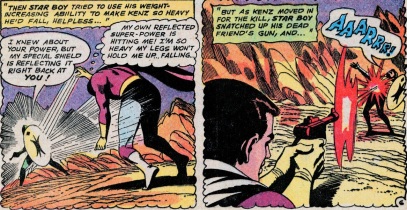
Well, the story ends with Star Boy being teleported into a trap by Althu, where the Master of Mass (patent pending) displays some really clever uses of his powers, despite the fact that the raiders have disabled the artificial gravity on their ship in order to render him helpless. Star Boy keeps the gang off balance until the cavalry arrives, and the Legion win the day!

All in all, this was a fun, solid Legion story. It had a nice dilemma, clever solutions, and fit a lot in its few allotted pages. The one real problem is the use of deadly force by Star Boy without so much as an eye-bat by ANYONE in the story. I kept expecting it to be revealed that he hadn’t actually killed the guy, but nope, apparently Star Boy is perfectly willing to bust a space-cap in a villain whenever it seems necessary. That sets a rather grim precedent for a 1970s comic book. All-in-all, I give it 3 Minutemen out of 5.

Aquaman #49

Cover Artists: Nick Cardy
Writer: Steve Skeates
Penciler: Jim Aparo
Inker: Jim Aparo
Letterer: Jim Aparo
Editor: Dick Giordano
As most folks who know me know, my favorite comic character is Aquaman. It wasn’t always thus. When I was a kid, my unalloyed favorite was Batman, but I did always have a soft spot for the King of the Seven Seas. Part of that is due to the fact that he has always had a really neat and unique look. What other hero is orange and green? Another part of it is that he inhabits such an amazing and interesting world, though writers and artists haven’t always taken advantage of that fact. You see, I’m a coastal boy, growing up in the islands and bayous of the Gulf Coast, sailing about in my little skiff since I was a kid, and living every minute I could on or in the water. Folks used to say I was part fish, so naturally I was drawn to the guy who could talk to our “finny friends.”
I’ve always been fascinated by the sea, but I’ve also had her treat me badly enough often enough to have a very healthy fear of both the water and what is in it. I’ve lived through half a dozen hurricanes, after all. Thus, I’ve always loved the idea of this hero, this adventurer, that not only wasn’t afraid of the sea, but ruled it, completely and utterly. Everything that lives and breaths underwater answers to him, and he is totally, completely at home under the waves, even more so than we are on land. That is pretty darn cool. If you can’t see the appeal of being able to breath and live underwater, then you’ve let the world beat too much of the wonder out of you. Every kid who has ever sat on the bottom of a pool, holding their breath, and wishing they stay under forever knows that it is a universal dream, ancient and powerful. Aquaman is the realization of that archetypal wish.

Yet, that is only part of my love for the character. Another significant reason is that I’ve always had a thing for underdogs. Give me the character that is (unjustly) maligned. Give me the hard-luck hero. Give me the guy that just can’t catch a break. I always see their potential, even when there isn’t all that much evidence around to engender faith in their underlying worthiness. Aquaman is perhaps the best example of this tendency, though some of my other DC favorites like Hawkman and the Atom also fit the bill.
Aquaman has really had a hard time of it, though. His book has been cancelled again and again, he’s become a cultural punch-line thanks to Super Friends, and his greatest enemy has become, not Ocean Master, not Black Manta, not even the Human Flying Fish, but DC Comics themselves.
You see, DC has, since the early 70s, apparently had it in for the Aquatic Ace. Now, I’m not suggesting some actual mustache-twirling, monocle-wearing conspiracy, so you can put away the tinfoil hats, but it just seems like the company consistently makes the wrong choices about this character, often inexplicably. They cancel his book when he’s selling well, they replace successful teams, they allow other media to mistreat and under-utilize the property, and weirdest of all, they publicly bad-mouth their own product. It’s like they collectively have a spot of madness where Aquaman is concerned. Of course, much of the blame for this attitude can be laid squarely at the feet of Super Friends. For every Rob Kelly, of Aquamanshrine fame, out there, who grew to love the Marine Marvel in that show, there are a thousand more that learned to regard him as a joke or as useless. Of course, he’s anything but, as any self-respecting DC fan can tell you.
HERE is a relatively brief Aquaman primer written by yours truly to educate those in the dark about this great character.
This particular comic is from right about the middle of what was, up until recently, arguably the best Aquaman run of all time. It is lamentably short, and its cancellation is perhaps the best example of DC’s inexplicable strikes against their own character. I’m talking, of course, of the legendary SAG run. The SAG run is the set of issues by the team of Steve Skeates (writer par excellence), Jim Aparo (artist extraordinaire), and Dick Giordano (editor and guiding light). They were a fantastic team, and under them Aquaman’s title, which had been slipping for years, started an impressive comeback. They finally treated the Sea King with the respect he deserved, explored the wonders of his underwater realm, and took his villains and supporting cast in interesting and intriguing directions. It wasn’t without its flaws, but these comics were Aquaman at the best he had ever been, for my money, and the best he would be for decades to come. He was a heroic, likable character, an adventurer who did what was right regardless of the cost, traits very soon to be lost for some thirty years. These stories are classic, Bronze Age comics at their finest.
Check out some of Aparo’s lovely splash pages from this run at Diversions of the Groovy Kind.

This issue is not the best of the bunch, but even so, it’s a solid, fun read, bursting with potential like so many of the issues of this run. It takes place shortly after the most famous story-line from the SAG run, “The Search for Mera,” wherein Aquaman tore through every kingdom under the sea in a hunt for his kidnapped wife. It also saw unrest and revolution in Atlantis, defused only by the bravery of Aquagirl (a character that I sorely miss being part of the Aquaman mythos). By the beginning of this story, however, things have begun to return to normal, and Aquaman and Aqualad are traveling in the frigid waters of Alaska to answer an emergency summons from an “old friend.” It’s funny how our heroes have so many old friends that make one appearance and are never heard from again. I guess superheroes are bad at keeping in touch…

Well, the tale actually opens with a silent, moody sequence of a black-clad diver destroying a building, leading in to a beautiful title page. Jim Aparo is one of my favorite artists of all time, and with the exception of the two astonishingly talented teams that have worked on Aquaman recently, Aparo’s work is hands-down the best version of Aquaman for my money. Ivan Reis and Paul Pelletier have done amazing work in the new Aquaman series, creating some of the finest comic book art of all time, but nonetheless, Jim Aparo is a giant in his own right. His work his this wonderful, flowing, liquid feel to it, and he is always doing something interesting with layout, position, and design. I’m no artist, but even I can appreciate the sheer beauty of Aparo’s work.

Back to the story! Our heroes are ambushed by frenzied fish that won’t answer to  Aquaman’s telepathic commands, and they are soon fighting for their lives. A strange figure in a diving suit shows up to help them, and it turns out to be Phil Darson, a somewhat enigmatic scientist and explorer who the Aquatic Ace had encountered some issues back. It seems that the mysterious malady plaguing the fish is the reason Aquaman has been summoned to these cold climes. The heroes meet up with Arthur’s “old friend,” Professor Davidson, and Aparo gives this briefly appearing, one-shot character a really distinct face. One look at this guy and you get a sense of his personality. He’s serious, grizzled, and worried, and we know this before he ever opens his mouth. That’s the power of a good artist right there.
Aquaman’s telepathic commands, and they are soon fighting for their lives. A strange figure in a diving suit shows up to help them, and it turns out to be Phil Darson, a somewhat enigmatic scientist and explorer who the Aquatic Ace had encountered some issues back. It seems that the mysterious malady plaguing the fish is the reason Aquaman has been summoned to these cold climes. The heroes meet up with Arthur’s “old friend,” Professor Davidson, and Aparo gives this briefly appearing, one-shot character a really distinct face. One look at this guy and you get a sense of his personality. He’s serious, grizzled, and worried, and we know this before he ever opens his mouth. That’s the power of a good artist right there.
Anyway, Davidson fills the Aqua-team in about what has been going on. Apparently factories in the area are poisoning the environment, and the fish with it, and a mysterious vigilante known as the Saboteur has been bombing the different businesses in retaliation. It has been a violent but bloodless attack until recently, when a night watchmen was killed in a blast. The exposition is nicely inter-cut with scenes of Saboteur striking again, and Aquaman rushes off to investigate. The Marine Marvel catches up to the destructive diver before he can get away, and the shadowy figure fires a miniature torpedo at him! Aquaman survives a near-direct hit (remember that for later), but the Saboteur gets away.

The mystery continues to unravel, with the introduction of a fat-cat industrialist type who is having none of this ‘save the environment’ nonsense! Not at the expense of HIS bottom line, you don’t! He lays a trap for the Saboteur, planning to kill him quietly so that he can prevent an investigation that would reveal his nefarious doings.

Cut back to Atlantis, and we get a brief, tense little scene between Mera and Ocean Master, who has apparently come in peace, complete with underwater white flag! We get to see Mera being a capable, intelligent ruler here, as well as hints of something waiting in the wings. Orm claims he needs to speak to Aquaman…but why?

Back in Alaska, Aquaman and Aqualad have a discussion about whether or not Davidson might be the Saboteur, and it is handled rather nicely. Instead of having this turn into a melodramatic, angsty teen-age drama, Arthur listens calmly to Garth’s thoughts, then he does the unthinkable. He puts stock in what his partner says and agrees that they can’t afford to take anything for granted. It’s a simple little exchange, but it shows the strength of the father-son bond between the two. Leaving Aqualad behind to watch Davidson, the Aquatic Ace heads out to investigate the remaining factory and encounters the Saboteur! This gives us a lovely little underwater scene that shows off Aparo’s skill.

Note Deadman’s face in the rock, a fun little teaser of what is to come in book’s future
 He follows the criminal, but it seems he breaks in on the factory owners planned ambush, and nobody is happy to see him! In another close call, Aquaman takes shrapnel from a grenade that explodes practically on top of him. That is two explosions he has survived, making him one tough son of a gun, right? Well, then we see one of the weaknesses of this series, as he is taken out by a clot to the head, in true DC hero fashion. I swear, if I had a penny for every time a DC hero is disabled by a blow the back of the head, I’d be living in my own underwater city….
He follows the criminal, but it seems he breaks in on the factory owners planned ambush, and nobody is happy to see him! In another close call, Aquaman takes shrapnel from a grenade that explodes practically on top of him. That is two explosions he has survived, making him one tough son of a gun, right? Well, then we see one of the weaknesses of this series, as he is taken out by a clot to the head, in true DC hero fashion. I swear, if I had a penny for every time a DC hero is disabled by a blow the back of the head, I’d be living in my own underwater city….

Anyway, this series mostly does a good job of showing how powerful, how tough, and how impressive Aquaman was, but every once in a while, they treat him just like a regular guy. Still, we’re treated to a really nice panel of Aquaman waking, literally BATHED in flames, and non-the-worse for the fiery wear. So, I suppose it isn’t all bad. He comes to in time to see the factory owner and the Saboteur locked in combat at the edge of a cliff, and before he can reach them, over they go! Aquaman makes his way down to the fallen Saboteur, and to no-one’s surprise, he discovers that it is the no longer quite so enigmatic Phil Darson under the mask. He explains that he loved the ocean and couldn’t stand to see it destroyed, so he took action when the law wouldn’t. He apologizes for attacking Aquaman, and the Marine Marvels are left in the falling snow, pondering the justness of his actions.

So, I’m sure we all saw the reveal coming. Phil Darson is the Chekhov’s gun of this particular story, the only piece that doesn’t fit without being found in the Saboteur’s flippers, but nonetheless, it’s a good story. I think it’s a shame that Darson was killed off, as he was an interesting character, always showing up when least expected. I would have liked to know more about what he had going on. The tale is an unusual one for Aquaman, more moody mystery than undersea adventure, and it makes for a nice change of pace. It is a little inconsistent with its treatment of Aquaman, and it really doesn’t give him or Aqualad all that much to do. Still, it’s a neat story, and the art is excellent, as always. This is only an average offering from the SAG team, but that still puts it a cut above average for most comics! I’d give it 4 Minutemen out of 5.

Batman #219

Cover Artist: Neal Adams
Writer: Frank Robbins
Penciler: Irv Novick
Inker: Dick Giordano
Backup
Writer:Mike Friedrich
Penciler: Neal Adams
Inker: Dick Giordano
This issue of Batman has two solid stories in it. The first involves Bruce Wayne trying to get federal money to support his then current VIP (Victims Inc. Programs) undertaking. That whole plotline loomed large in these middle years, but it doesnt’ seem to have amounted to much in the Bat-mythos. Instead, as with so many comic characters, the elements that have stuck are those that were there in the beginning, or almost so, at least. The skyscraper lair has been replaced by Wayne Manor and the Bat-Cave, and in general, those original concepts seem to have staying power.
But back to the story at hand. Bruce is seeing a senator at his office who introduces him to a secretly visiting old warhorse of “our party.” It’s hard to imagine Batman engaging in partisan politics, so this was a minor little note that struck me as a more than a little off key. It’s rather strange to see the Dark Knight engaged in politics to begin with, but that’s not the only offbeat bit of this story.

 The Senator convinces Bruce to fly back to D.C. with him to help with a crime bill that’s supposed to really make waves, and on the way, the flight is hi-jacked by his political enemies! In a nice little touch, the pilot seems, not scared as you’d imagine, but nonplussed and wearily resigned, if anything. “Not another Havana Hijacker,” he says grumpily. Apparently this period, from ’68-’79 is the “Golden Age of Skyjacking,” so I suppose this scene speaks volumes about the ubiquity, the almost hum-drum regularity of such events here in the Bronze Age.
The Senator convinces Bruce to fly back to D.C. with him to help with a crime bill that’s supposed to really make waves, and on the way, the flight is hi-jacked by his political enemies! In a nice little touch, the pilot seems, not scared as you’d imagine, but nonplussed and wearily resigned, if anything. “Not another Havana Hijacker,” he says grumpily. Apparently this period, from ’68-’79 is the “Golden Age of Skyjacking,” so I suppose this scene speaks volumes about the ubiquity, the almost hum-drum regularity of such events here in the Bronze Age.
What follows is a somewhat amusing comedy of errors with Batman switching between his Bruce Wayne and Caped Crusader identities. First, in one of those other slightly sour notes I mentioned, Bruce takes on the skyjackers single-handedly, in full view of the public, unmasked. Way to protect your secret identity there, Bats.
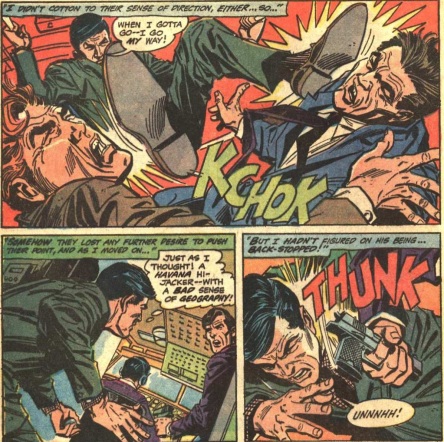
He gets thumped on the head for his troubles (Another one! I’m going to start a running tally) and thrown into the back of the plane. He wakes up, uses a “Mae West,” which I did not realize is an inflatable life raft (who says comic books aren’t educational?) to fill his vacated civilian clothes, and sets out to take on the bad guys as Batman! Then he…promptly gets knocked out…AGAIN! The skyjackers toss Bats back with Bruce (!), fortunately not bothering to check on their other prisoner. This does offer Batman a chance for a witty little rejoinder, though, so that’s something.

Finally, Bats fools the villains with a few quick changes and has the Senator fake a heart-attack, hoping that these criminals don’t want him dead. While flying to a nearby medic, the Batsuit rigged to that previously mentioned “Mae West” (Chekhov’s raft, apparently), springs out of a compartment and scares the skyjackers silly. The Senator (and the other passengers, but who cares about them?) is saved, and we’re left with Bruce pondering an invitation to get into politics full time.

This is a solid Bat-story, not particularly remarkable, but certainly not bad. Bruce is a little too quick to take the bad guys on single-handed without his costume, especially considering the excellent job Bob Haney did (how often does someone say that about logical consistency?) just last month with a similar situation. Still, this was fun, with a neat resolution. I’ll give it an average 3 Minutemen.

“The Silent Night of the Batman”

The backup tale in this issue is the one I particularly enjoyed, which seems to be becoming a trend in these multi-part books. It’s a simple but sweet little Christmas story. It’s almost entirely silent, except for a strain of different Christmas carols moving through the pages. There isn’t really all that much to the plot, and in this case, that’s not really a problem. Commissioner Gordon tricks Batman into coming down to the precinct so he can force the Caped Crusader to take a night off. He convinces the Dark Knight to stay and sing Christmas carols (!) until there is an emergency. Batman, sure that something will momentarily go horribly wrong, begrudgingly agrees. There’s an odd but funny little beat where the cops ask him to lend his “deep vocal chords” to their songs.
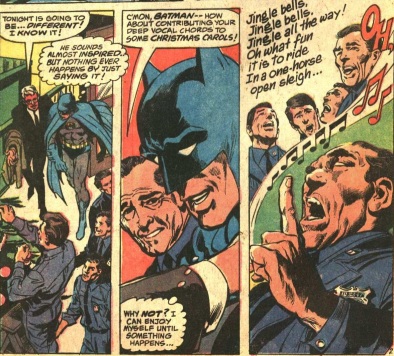
We then travel around Gotham, seeing several moments where tragedy COULD strike, but doesn’t because of the Christmas spirit, along with a healthy dose of the spirit of Batman as well! It’s a touching set of silent stories where people choose a better path, at least in part because they were inspired by Batman. It’s a really a lovely expression of how the presence of heroes can improve the world, outside of their immediate actions. Having truly virtuous, truly heroic figures to look up to can make us all better. In the end, Batman wakes, having fallen asleep on a quiet, uneventful night. It’s a good ending. It is strange, even incongruous to see Batman singing Christmas carols, but it is charming and enjoyable nonetheless.



I give this one 4.5 Minutemen out of 5.

Detective Comics #396

Executive Editor: Carmine Infantino
Cover Artist: Neal Adams
Writer: Frank Robbins
Penciler: Bob Brown
Inker: Joe Giella
Editor: Julius Schwartz
“The Orchid-Crusher”
Writer: Frank Robbins
Penciler: Gil Kane
Inker: Murphy Anderson, Gil Kane
Editor: Julius Schwartz
This is an odd little tale, full of 60s-ness, and more than a little reminiscent of a Zany Haney script, but it has its moments nonetheless. The issue opens with Bruce Wayne in his office having an “eyeball-to-eyeball confrontation with the ‘youth revolution'” as he reads NOW! Magazine, which apparently has a plot convenient cover story. This is where I had to double check the credits to be sure this wasn’t a Bob Haney yarn.  The whole plot turns on the idea that there is this young whiz kid named Rory Bell who is a stock genius, and makes all of his business decisions while riding a motorcycle and talking to his secretary/girlfriend via “radio-phone”! To add to the oddness of this concept, apparently a gang of crooks who are feeling a bit out of date decide that the best way to turn things around is to kidnap this kid and have him make a fortune on the market for them. We are on page 2.
The whole plot turns on the idea that there is this young whiz kid named Rory Bell who is a stock genius, and makes all of his business decisions while riding a motorcycle and talking to his secretary/girlfriend via “radio-phone”! To add to the oddness of this concept, apparently a gang of crooks who are feeling a bit out of date decide that the best way to turn things around is to kidnap this kid and have him make a fortune on the market for them. We are on page 2.

It’s amazing how many concepts a minute these creative teams threw out back in the day.
So, these enterprising gangsters kidnap the kid, who, in a scene chock full of migraine inducing 60s slang, convinces these geniuses he “can’t make market decisions ‘less I’ve got this throbbing heap under me…and the wind blowing my mind!” I don’t know about you, but I think that’s the kind of thing I’d keep to myself. Just saying.

Well, it just so happens that this fellow’s girl Friday is Bruce’s stock broker as well, and the kid sends an S.O.S. by ordering a number of uncharacteristic sales and buys. When the broker discusses this with Bruce (isn’t that insider trading?), he deduces the pattern and sets out as Batman in a decent display of detective work.

He ambushes the gangsters when they stop at a gas station, and almost puts them down before one of them grabs the kid as a hostage. Batman drops a smoke pellet, and in the highlight of story, he fakes the gang out by sending the Batmobile tearing away under remote control so he can get the drop on them.

There’s not a whole lot to this one. It’s a solid enough story, but not a particularly good one. It’s enjoyable for what it is, and all of the characters are given just enough personality to make them more than just moving pieces of scenery. Still, it is more than a bit forgettable. I give it 3 Minutemen.

“The Orchid Killer”

This Batgirl backup is interesting, though you really feel that the Robbins was a bit constrained by the 9 page limit. The story opens with our lovely red-headed crime fighter having a nightmare about a mysterious killer that’s been haunting Gotham lately. He’s known as the titular “orchid killer” because he always leaves a crushed orchid at the scene of each crime. At this point in her history, Babs is a librarian, a reasonable if unexciting secret identity for a superhero, I suppose. Librarians have interesting jobs, but it doesn’t seem like quite the vocation that Barbara Gordon should have.

Employment aside, she stumbles upon a clue to the crime in a copy of The Femme Mystique, a computer punch card (how quaint!). It seems to be a computer dating service quiz (I didn’t even know they HAD computer dating services in 1960) belonging to the latest victim! It appears the books previous possessor was studying up on how to manipulate women (creepy!), and a passage about orchids is underlined. Babs does some detective work, tracking the library book back to a man named Darren Thompkins. He’s apparently skipped out of his boarding house, so Batgirl pays a visit to the computer dating service and sets a trap using herself as bait!

In order to do so, she has to remorsefully brush young Jason Bard off. It’s a nice moment of background and characterization, especially in a story as tightly plotted as this one. Jason is a long-time part of Batgirl’s supporting cast, as I understand it. While I like the character, I don’t like him being Babs’ love interest. I’m an old romantic, I suppose, but I’ve always loved the pairing of Robin and Batgirl. It just made perfect sense, and they complement each other excellently. I would have read the heck out of a backup strip that featured both of them.

 Back to our mystery. Barbara gets a nibble, and her date is a mousy little fellow who seems harmless…until he offers her an orchid and moves in for a kiss. Babs rebuffs his advances rather…decisively, and he storms off. She follows, not quite sure if this is just natural frustration or something more sinister, and she loses him, only to be grabbed, apparently by the orchid killer himself!
Back to our mystery. Barbara gets a nibble, and her date is a mousy little fellow who seems harmless…until he offers her an orchid and moves in for a kiss. Babs rebuffs his advances rather…decisively, and he storms off. She follows, not quite sure if this is just natural frustration or something more sinister, and she loses him, only to be grabbed, apparently by the orchid killer himself!

 This backup ticks right along, but it manages to tell a complete story, so far as it goes, in only 9 pages. I’m not quite sure what I think of the opening dream sequence. It does establish a good, creepy tone and a sense of threat about this killer, but I wonder if that page could have been put to more effective use. Nonetheless, packing all of that story into 9 pages is pretty impressive, and Robins does it very efficiently. You get some characterization, some supporting cast, some civilian identity, some superheroing, and some detective work. Not bad. I’ll give it 3.5 Minutemen.
This backup ticks right along, but it manages to tell a complete story, so far as it goes, in only 9 pages. I’m not quite sure what I think of the opening dream sequence. It does establish a good, creepy tone and a sense of threat about this killer, but I wonder if that page could have been put to more effective use. Nonetheless, packing all of that story into 9 pages is pretty impressive, and Robins does it very efficiently. You get some characterization, some supporting cast, some civilian identity, some superheroing, and some detective work. Not bad. I’ll give it 3.5 Minutemen.

The Flash #194

Cover Artist: Neal Adams
Writer: John Broome
Penciler: Ross Andru
Inker: Mike Esposito
I really do love the Flash as a character, especially the Barry Allen version. Yet, reading these Flash comics has routinely been one of the hardest slogs of my grand DC experiment. It’s strange, I expected to love these comics. After all, Flash has some of the best villains in the DC Universe, and I am a fan of Barry Allen himself. I love that he is just a really decent, upright man, all other concerns aside. He’s the only DC hero other than Hawkman that was a crime-fighter BEFORE he had super powers. He was a police scientist, already having dedicated his life to protecting people. It’s a great concept, and the Flash as a character is one as well. Nonetheless, I routinely found this book to be pretty rough going. I think it may be the most Silver Age-y book in the DC offerings other than the Superman and Batman titles. There have been some good stories along the way, and this period has given us a whole Rogue’s Gallery of great villains (and some NOT so great ones *cough*TheTop*cough), but there has also been tons of Silver Age weirdness and general silliness.
Nonetheless, by this point Barry has settled into a pretty enjoyable status quo. He and Iris are married, and Iris has gone from being occasionally downright insufferable to a genuinely likeable character. That’s good, because DC love interests in the Silver Age had a hard time of it, often being portrayed as either bat-guano insane or downright mean. You really had to wonder why the heroes were interested in such ill-tempered or unstable ladies. It seems to me that a lot of readers hold those portrayals against those characters, but I try to avoid letting bad writing ruin a character for me when they have good potential, and Iris, as an independent career woman in the 60s certainly fits the bill.
This issue is, unfortunately, a weird story from the middle of a run of weird stories. Remember all of those great villains the Flash has? Well, don’t expect to see any of them anytime soon. Instead, we get a dozen issues of random oddness. This story is an incongruous tale of magic and mysticism that would be a much better fit for the Phantom Stranger than the Scarlet Speedster. The cover is an interesting one, and you’re really left wondering what the heck is going to happen within this book. Sadly, the story doesn’t quite live up to that mysterious beginning. At the start, we find a seemingly confused young lady wandering the darkened streets of Central City, where she encounters the Flash fighting one of those delightful themed gangs that seemed to be all over the place in the Silver Age. This is one little element of the period that I wished we still saw a bit more of. This “Owl Gang” have some relatively neat costumes and some distinctive headgear that lets them blind the Wizard of Whiz, but he recovers too quickly for them and rounds them up without much trouble.

Seriously, there are a bunch of these little themed gangs scattered through the pages of various DC books. They don’t amount to much, and I am pretty sure 99% of them never make a return appearance, but I like the idea that even the fairly mundane criminals in a world of super-powered beings get in on the fun of costumes and gimmicks. It makes the setting that much more fun and lively! I wish that writers had kept these gangs around a bit more, replace some of the generic thugs that populate their pages with recurring appearances by the likes of the Owl Gang, or the Panther Gang from the Atom, etc. I think that would have been interesting.
 Anyway, this young lady gets a bad fright during the fight and passes out, so the Flash naturally takes her to a hospital where professionals can take care of her and…wait…what? No, no, no, don’t be silly. Instead, at Iris’s insistence, he brings her to his home where he can more conveniently endanger his secret identity. The girl awakes and calls the Scarlet Speedster “Daniel,” giving him a SUPER creepy look in the process.
Anyway, this young lady gets a bad fright during the fight and passes out, so the Flash naturally takes her to a hospital where professionals can take care of her and…wait…what? No, no, no, don’t be silly. Instead, at Iris’s insistence, he brings her to his home where he can more conveniently endanger his secret identity. The girl awakes and calls the Scarlet Speedster “Daniel,” giving him a SUPER creepy look in the process.
Barry is naturally weirded out by this, and over the next day things continue to get stranger. The girl awakes and insists that The Flash, who is still running around his actual house in costume, mind you, is her fiance, Daniel. Even stranger, Barry begins to see visions of himself as this fellow, circa 100 years ago. Iris digs up some history and an old photo that marks this Daniel guy as the spitting image of Barry himself. The Allens begin to suspect that the girl is possessed by a restless spirit (naturally), and feel that their surmise is correct when they discover she has…*gasp* two shadows!
Flash jumps to the only rational solution. He has to fake marry the girl. That’s right. That’s the first thing he comes up with. So, they go through with the ceremony, and instead of putting the spirit to rest, it somehow allows her to drag the Fastest Man Alive into some kind of bizarre Limbo along with her!

This is where the story takes an even stronger term to the weird and where its use as a Flash yarn comes into serious question. Flash finds himself trapped, besieged by demons, or spirits, or something, but luckily still possessing his super speed. He attempts to race out of the strange dimension, but finds himself beset by threat after threat, including giant monsters and harpies. If you’re thinking that it sounds like this mysterious spirit bride seems to drop out of the story, you’d be correct. She literally just floats away immediately after they find their way to Limbo…or wherever, making this tale feel even more disjointed. Eventually Flash RUNS out of the afterlife. I don’t mean that he vibrates himself to escape the dimension or anything. I mean that he literally just runs to the edge of…wherever…and falls back into normal life. Oookay.

I like all of the crazy dimension-hopping antics of the Flash. I love the idea that simple SPEED is such a versatile power. I’m fine with such things, but this weird little episode is a bit much and, as I said, it just feels out of place as a Flash adventure.
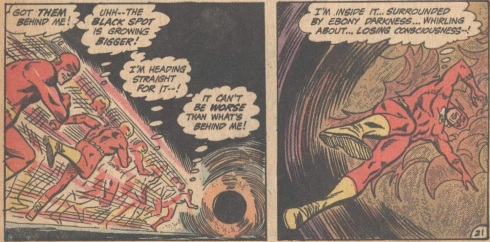
What’s more, this strange ‘afterlife’ he finds himself in is just really vague and boring. aristi Ross Andru does an okay with the weird creatures that inhabit it, but I just can’t help but find myself thinking about how interesting and exciting this same concept would have been if handled by somebody with the imagination of Jack Kirby. The dimension would have been bursting with potential and personality, and as a reader you’d be left begging to see more of it, as likely as not. Instead, his place is entirely forgettable, and I’m fairly certain we never see it again.

This isn’t a BAD story, but it is definitely not a good one. The action is moderately interesting, but the whole thing just makes such little sense and the limbo-realm is just so uninspired that I think I’ll give this one 2.5 Minutemen.

Justice League #78

Cover Artist: Gil Kane
Writer: Dennis O’Neil
Penciler: Dick Dillin
Inker: Joe Giella
Now here’s one I’m excited about! This is, by pure happy coincidence, the official beginning of the Satellite Era Justice League! I didn’t realize that this issue would fall within my purview, but I’m glad it did. After all, what better way to celebrate the Bronze Age than by chronicling the adventures of its most definitive team? The Satellite Era Justice League is the group that most clearly encapsulates this period. That incarnation begins here at the dawn of the the age, and it comes to its sad end just as the Bronze Age itself draws to a close in ’84. It just so happens that the JLA are my all-time favorite comic team. A child of the 80s, as any regular reader knows, I grew up watching re-runs of the Super Friends and playing Justice League with my friends. We all had footie pajamas of our favorite heroes, and we’d put on those silly little Velcro capes and dash about, fighting the Legion of Doom or playing with those awesome Super Powers action figures.
These guys WERE the heroes of my child-hood. I think I may have been vaguely aware of Spider-Man, Captain America, or the Hulk, but Superman, Batman, Aquaman, Wonder Woman, those were the heroes that filled my imaginative hours, long summer days, and halcyon Saturday mornings. I didn’t read many of the comics at the time, but I absorbed enough about these characters through other media to leave an indelible mark on my imagination. They became the lens through which I understood the concept of the superhero. That’s why, even though Super Friends is cringe-worthy for me these days, even though a lot of the classic comics are pretty painfully Silver-Agey at times, I will always have a soft spot for the DC Universe, but especially its heart and soul, the Justice League.
They are the Knights of the Round Table of superheroes, each powerful, noble, and impressive in their own right, but banded together in common cause, to make the world a better place, to fight for those who cannot fight for themselves, and to protect the Earth from threats too big for any one hero. They are, collectively, what Batman and Superman are individually, the purest expressions of the archetypal nature of the superhero. The League is like the old pantheons, powerful titans and godly figures of might, each presiding over their own demesne of skill and elemental purview. Though an odd assortment, it has always seemed to me that they make a more coherent team than the Avengers. I suppose that says something about the relatively uniform aesthetic of the core DC heroes.
Unfortunately, their stories have often not lived up to the quality of the concept. I have regularly wondered how the Justice League book survived after Marvel started competing directly with their Avengers. On average, the Avengers stories in the Silver Age were just so vastly better, you really have to wonder why folks stuck with the JLA. Don’t get me wrong, I’m glad the book endured, but it boggles the mind to think about. And of course, just like Aquaman, this lack stellar storytelling in the critical Silver Age has been a weakness for the team going forward. Whereas the Avengers ended up with a lot of great villains and concepts produced by that most fertile era, the League has always struggled for villains and challenges that really can serve as interesting threats for them. The period that saw Kang the Conqueror fight the Avengers also saw the League facing off against the likes of Brain Storm and Kanjar Ro, not exactly winners. Of course, I’m comparing hits with misses, but I think you get my point. There were some great villains introduced in this era, but this has always been one of the weak points of the League, something Bruce Timm and company struggled with when creating their amazing Justice League Animated Series.
While I think it may continue to be the case that the concept of the League is stronger than the stories they produce in the Bronze Age, at least here the tide begins to turn, and we get some really excellent stories. In general, the quality of stories does improve, and even more significantly, the team takes on the shape, themes, and challenges that will define it for the rest of its history.
This story brings us about midway into Denny O’Neil’s justly famous JLA run. O’Neil took over after Gardner Fox’s decade-long and legendary time on the book, and with him came big changes. He introduced new members, wrote out old ones, and gave the League their definitive Satellite headquarters. O’Neil updated the team and did a lot of good work in these issues. The Satellite and the introduction of Black Canary are both great additions to the mythos, but he also did some things that I’ll always regret. He wrote out the Martian Manhunter, who at this point has headed to another world to help his people colonize it. The League without its soul, J’onn J’onzz is like a church without a choir. You can do it, but something’s missing. It’s a particular shame that, just as the DC staple of heroes begin to get some good characterization, to realize the potential that they have, the Manhunter from Mars is removed from the game.
Anyway, this is the tale, as you can probably guess from the cover, that gives us the Justice League satellite, an excellent addition to the mythos that really fits the League perfectly. Our story begins with the Emerald Archer patrolling around Star City when he hears gunshots and rushes to the aid of an embattled security guard who is involved in a shootout with some thugs.

Rather, GA INTENDED to help the guard, but the fellow seems to need no help at all! In a display of sharpshooting and daring do, he disarms the thugs without breaking a sweat. It’s an impressive deed, and it hints at the mysterious man’s identity! Green Arrow attempts to shed some light on the situation with a flare arrow, but in a shocking turn, the flare sets the river alight! This leads us to a rather nice title page.


Ollie calls in the League in a rare moment of self-awareness and wisdom, realizing that this blazing inferno is too much for him to handle. Superman and Green Lantern respond and quickly have the fire under control. The Leaguers head off to their fancy new satellite headquarters, and GA gets quite a surprise when they toss him in a teleport tube and flip the switch. We get our first view of the satellite, orbiting “about 22,3000 miles above the United States.” We also get a small but nifty diagram of the layout. I enjoy things like this. I used to spend hours pouring over base layouts and the like, imagining all of the cool gear and secrets that would fill, say, the Turtle Lair.

The real star of the issue
 We join that security guard, who seems to be more than meets the eye. No, he’s not a transformer, but the way he ducks the hoodlums who come gunning for him implies that he’s got some skills. Apparently he’s being hunted, and he feels his only hope is the Justice League! He reads about the League making a charity appearance, and he figures that is his chance. This page also gives us a pick-up line delivered by Green Arrow with a creepy and altogether too intense look on his face. Way to play it cool, Ollie. At the event, just as the new Leaguer, Black Canary, is being introduced, this unusual guard forces his way through the crowd, assassins hot on his heels. The League leaps into action in a rather nice display of their collective skills and teamwork, and the guard reveals his identity and his story.
We join that security guard, who seems to be more than meets the eye. No, he’s not a transformer, but the way he ducks the hoodlums who come gunning for him implies that he’s got some skills. Apparently he’s being hunted, and he feels his only hope is the Justice League! He reads about the League making a charity appearance, and he figures that is his chance. This page also gives us a pick-up line delivered by Green Arrow with a creepy and altogether too intense look on his face. Way to play it cool, Ollie. At the event, just as the new Leaguer, Black Canary, is being introduced, this unusual guard forces his way through the crowd, assassins hot on his heels. The League leaps into action in a rather nice display of their collective skills and teamwork, and the guard reveals his identity and his story.

It seems that lowly security guard Greg Sanders is actually the costumed western hero, Vigilante! Or rather, he used to be. He confesses that he ‘got weary, decided to retire,” which is an extremely unsatisfying answer to how the famous Prairie Troubadour ended up working as a low-rent security guard in Star City! However, there is just enough wistfulness mixed with determination in those two panels to sell the idea that there is a great deal more to the story that we simply aren’t privy to.

The tale Sanders tells about his troubles is that he was working at a factory and became suspicious of its activities, eventually doing some snooping and discovering that the place seems to exist ONLY to manufacture pollution, nothing else, thus explaining the flammable river. He stole some documents which he shares with the League, and they do what they do best…split into teams and investigate!
 The more street-level characters head out to investigate the factory, while Superman and GL head out to investigate the location on a star map discovered in the papers. Green Arrow, being Green Arrow, tells everybody else that he’s got his own plans. He marches into city hall and gives the assistant city manager an earfull. In an agressive verbal boxing match, the two yell at each other, with Ollie saying things that may have been a bit shocking in 1970 but seem utterly mundane now, basically that we should probably not poison ourselves or our environment for a buck. He deploys his usual diplomatic subtlety, insulting the official and screaming in his face. The manager is having none of it and has the masked hero arrested!
The more street-level characters head out to investigate the factory, while Superman and GL head out to investigate the location on a star map discovered in the papers. Green Arrow, being Green Arrow, tells everybody else that he’s got his own plans. He marches into city hall and gives the assistant city manager an earfull. In an agressive verbal boxing match, the two yell at each other, with Ollie saying things that may have been a bit shocking in 1970 but seem utterly mundane now, basically that we should probably not poison ourselves or our environment for a buck. He deploys his usual diplomatic subtlety, insulting the official and screaming in his face. The manager is having none of it and has the masked hero arrested!

Meanwhile, the Vigilante rides again, and apparently catches Black Canary’s eye (see Ollie, this is what happens when you over play your hand!) while Superman and GL discover a dead world that was once teeming with life! Team-Earth is jumped by some more of the trench-coated thugs and make short work of them until a shadowy figure disables them with booby trapped weapons!

The issue ends with our heroes suspended above a “vat of bubbling, noxious…death!”

This issue also contains a little four page backup about a scientist who destroys all of his equipment after seeing a future destroyed by…SCIENCE! It’s a fine story for what it is, originally published in Mystery in Space #6.
I read this JLA issue some years ago, but I didn’t really remember it very clearly. I went into this read thinking that the issue was nothing special, but I have to say that I have been very pleasantly surprised. It’s a good, solid Justice League adventure, with some good action beats, a mystery, and a few spots of characterization. All of the Leaguers get a little something to do, though the story really centers around GA and Vigilante, and splitting the team the way O’Neill did makes sure the stronger Leaguers don’t overshadow the weaker. It’s really great to see Vigilante get in on the action. I rather like the character, and I especially loved the friendship between him and Shinning Knight that was explored in the Justice League animated series. Speaking of that, I enjoy that they adapted the broad strokes of Green Arrow’s introduction to the satellite from this issue for his induction into the League in the show. That’s a nice little detail. While it’s great to see Vigilante get back into costume, I have to say, it’s a little distracting to see the smiling, Silver Age-ish Batman standing next to him, especially considering the sleek, dramatic, and classic Batman we’ve been getting in the Bat-books this month and last. That’s neither here nor there, though.
So, all-in-all, this is an above average Justice League adventure, well balanced, well-paced, and interesting. I give it 4 Minutemen out of 5. We’ll have to wait and see if the other half of this story lives up to the beginning!

P.S.: I just discovered that the river fire in this book must have been a reference to a contemporary event! In June of 1969, the terribly polluted Cuyahoga River in Ohio caught fire and blazed away, doing $100,000 of damage. The incident was immortalized on the cover of Time Magazine, drawing national attention and helping to spark the beginning of the environmentalist movement. This story was in the headlines when Denny O’Neil would have been writing JLA #78, and there is little doubt that it must have been the inspiration for this particular comic. That’s a fascinating sign of the rising social consciousness in comics, and it puts the environmental overtones of this story in a very different light.
Closing Thoughts:
Well, I think that, in order for these posts not to stew for months at a time, I’ll post them in chunks. I tend to write an entry a day or so, but there are a lot of entries to each month, and I end up sitting on a lot of content for weeks that way. I think I’ll break it into two, maybe even three or four, posts that can get content out more frequently. After all, this is a LOT of material, so breaking it up is probably not a bad idea. The last post of each month’s collection will contain my general reflections and notes. If readers have any preferences for how they’d like me to cover each month, I’d be more than happy to listen.
And, as promised, I’m starting a new, running feature that will be updated with each post. Introducing-
The Head-Blow Headcount:


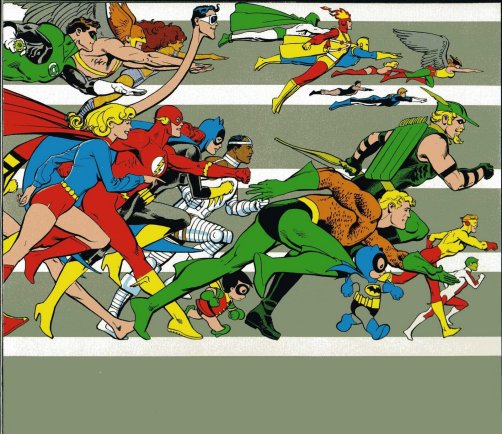
 “The Last Survivors of Earth!”
“The Last Survivors of Earth!”








 Finally, in California, Batman is left alone to confront the arriving Muian ship, and his valiant but foolhardy barehanded attack against the technological marvel, ends in defeat. It’s a shame he didn’t have an advanced jet with all kinds of weapons on hand. Once again, Green Arrow’s temper gets everyone in trouble. The League just might be better off without him.
Finally, in California, Batman is left alone to confront the arriving Muian ship, and his valiant but foolhardy barehanded attack against the technological marvel, ends in defeat. It’s a shame he didn’t have an advanced jet with all kinds of weapons on hand. Once again, Green Arrow’s temper gets everyone in trouble. The League just might be better off without him.

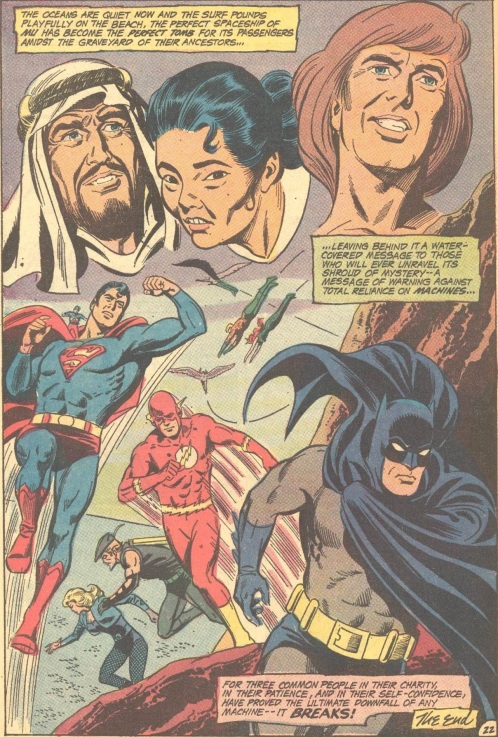
 Despite the slightly awkward ending, there are a lot of neat elements in this tale, interesting and thoughtful little touches, like having Aquaman be called in as an expert in lost civilizations, some decently graceful attempts at exposing readers to other cultures, and even a little romantic intrigue. The lost continent of Mu itself is a really fascinating concept, and it’s a shame it didn’t get a bit more development here, though that’s often the case for comics of this era. I’m curious if anyone else ever made anything of the seeds planted in this story. The threat the heroes face is one well suited to the League, and it’s an interesting change of pace that the team doesn’t actually save the day. Most everyone gets something to do, though Aquaman gets the short end of the stick, as usual. Dillin’s art is uneven in this one, alternately very strong and rather awkward, but for the most part he turns out a very pretty book. There are a few just strange looking panels, though, like Batman’s awkward run. In any event, this is an enjoyable read without the weirdness of the some of our previous issues. I’ll give this one a solid 3.5 Mintuemen.
Despite the slightly awkward ending, there are a lot of neat elements in this tale, interesting and thoughtful little touches, like having Aquaman be called in as an expert in lost civilizations, some decently graceful attempts at exposing readers to other cultures, and even a little romantic intrigue. The lost continent of Mu itself is a really fascinating concept, and it’s a shame it didn’t get a bit more development here, though that’s often the case for comics of this era. I’m curious if anyone else ever made anything of the seeds planted in this story. The threat the heroes face is one well suited to the League, and it’s an interesting change of pace that the team doesn’t actually save the day. Most everyone gets something to do, though Aquaman gets the short end of the stick, as usual. Dillin’s art is uneven in this one, alternately very strong and rather awkward, but for the most part he turns out a very pretty book. There are a few just strange looking panels, though, like Batman’s awkward run. In any event, this is an enjoyable read without the weirdness of the some of our previous issues. I’ll give this one a solid 3.5 Mintuemen.
 “Orion Fights for Earth!”
“Orion Fights for Earth!”





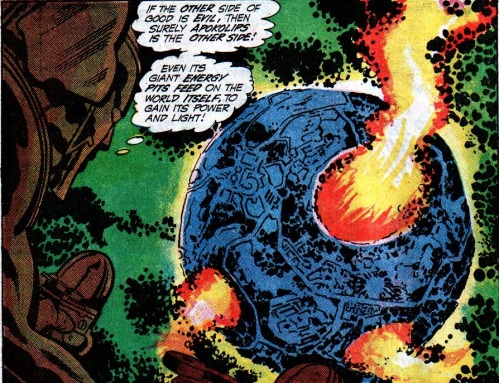


 The scholar warns the warrior of Darkseid’s plans, telling him that the Apokaliptian monarch even now works on a device that will allow him to search all of the minds on Earth for the mysterious and sinister ‘Anti-Life Equation.’ Before vanishing as mysteriously as he appeared, he also reveals that Darkseid began his search there on Apokolips with a quartet of kidnapped humans. The warrior frees the captives, and holding Kalibak off, opens a boom tube to Earth to help them escape.
The scholar warns the warrior of Darkseid’s plans, telling him that the Apokaliptian monarch even now works on a device that will allow him to search all of the minds on Earth for the mysterious and sinister ‘Anti-Life Equation.’ Before vanishing as mysteriously as he appeared, he also reveals that Darkseid began his search there on Apokolips with a quartet of kidnapped humans. The warrior frees the captives, and holding Kalibak off, opens a boom tube to Earth to help them escape.

 Then to War! Wow! Summarizing this book was a real challenge. Since so much of this is new and since there are so many big ideas flying around, it is tough to be brief when talking about this story. In fact, I left some interesting moments untouched, like the glimpse of New Genesis’s culture revealed in Highfather’s reverence for the innocence of youth, which itself is an effective shorthand for his world’s love of freedom and for the stakes for which this galactic game shall be played. In general, this is a great story, though it will eventually be overshadowed by what comes after. Kirby’s art is a little rough in some spots, and of course Colletta’s inking doesn’t do him many favors. None the less, the visual imagination at play is wonderful, with both New Genesis and Apokolips fitting perfectly into their archetypal roles. Kirby’s imagination is clearly unleashed in this book, and the fruits of his labors are wondrous. There are Promethean structures everywhere, and many panels stress the scale of the world we’ve entered, as Orion is shrunk to insignificance before a starfield or an ominous edifice.
Then to War! Wow! Summarizing this book was a real challenge. Since so much of this is new and since there are so many big ideas flying around, it is tough to be brief when talking about this story. In fact, I left some interesting moments untouched, like the glimpse of New Genesis’s culture revealed in Highfather’s reverence for the innocence of youth, which itself is an effective shorthand for his world’s love of freedom and for the stakes for which this galactic game shall be played. In general, this is a great story, though it will eventually be overshadowed by what comes after. Kirby’s art is a little rough in some spots, and of course Colletta’s inking doesn’t do him many favors. None the less, the visual imagination at play is wonderful, with both New Genesis and Apokolips fitting perfectly into their archetypal roles. Kirby’s imagination is clearly unleashed in this book, and the fruits of his labors are wondrous. There are Promethean structures everywhere, and many panels stress the scale of the world we’ve entered, as Orion is shrunk to insignificance before a starfield or an ominous edifice.
 I’ve mentioned how archetypal this story is, and that is an important part of its success, as the King is essentially creating a new myth, working in the broad, bright colors of legend, evoking the eternal struggle of the Norse Gods, the Olympian war against the Titans, or similar cosmic conflicts. This is a larger scale, a much larger scale, than anything we’ve seen in DC Comics, and clearly already more fully realized than any similar worldbuilding we’ve seen in the last year. The only parallels can be found in Kirby’s own work in Marvel, but with the Fourth World the King seeks to surpass even those heights . Think about how astonishing this book must have been when it hit the stands amongst the mundane everyday stories filling DC’s books. Even this month’s Justice League tale, which has some measure of imaginative reach, feels positively cramped and halfhearted by comparison. Despite that, he’s doing some pretty solid character work even from this first chapter, especially considering the era. There are mysteries surrounding Orion, and a lot of personality at play in everyone we meet. The impression of depth is downright palpable, and you just know that this conflict sprawls far beyond the pages of this book. What’s more, we can see the lasting impact of this story in the fact that so many of its elements, even just from this first entry, have gone on to become central elements of the DC Universe. It’s a great beginning, and I can’t wait to read the rest of the series! I’ll give this first chapter 4.5 Minutemen, as it loses just a little for the clunkier moments.
I’ve mentioned how archetypal this story is, and that is an important part of its success, as the King is essentially creating a new myth, working in the broad, bright colors of legend, evoking the eternal struggle of the Norse Gods, the Olympian war against the Titans, or similar cosmic conflicts. This is a larger scale, a much larger scale, than anything we’ve seen in DC Comics, and clearly already more fully realized than any similar worldbuilding we’ve seen in the last year. The only parallels can be found in Kirby’s own work in Marvel, but with the Fourth World the King seeks to surpass even those heights . Think about how astonishing this book must have been when it hit the stands amongst the mundane everyday stories filling DC’s books. Even this month’s Justice League tale, which has some measure of imaginative reach, feels positively cramped and halfhearted by comparison. Despite that, he’s doing some pretty solid character work even from this first chapter, especially considering the era. There are mysteries surrounding Orion, and a lot of personality at play in everyone we meet. The impression of depth is downright palpable, and you just know that this conflict sprawls far beyond the pages of this book. What’s more, we can see the lasting impact of this story in the fact that so many of its elements, even just from this first entry, have gone on to become central elements of the DC Universe. It’s a great beginning, and I can’t wait to read the rest of the series! I’ll give this first chapter 4.5 Minutemen, as it loses just a little for the clunkier moments.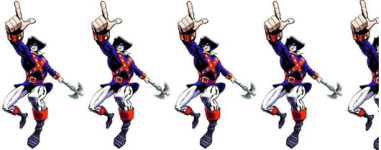
 “The World of the Super-Ape!”
“The World of the Super-Ape!”
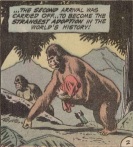
















 “Return of the Alien!”
“Return of the Alien!”





 She explains that her captors have opened her mind and taught her to think for herself, strangely enough. Yet, even more surprising, when he tells the young lady that he’s there to rescue her, she refuses, saying she’s happy in her role! While she may be a captive, she is, in many ways, more free than she was in her oppressive home. It’s an interesting wrinkle and an unexpected twist. Yet, it is also a bit unsatisfying. Our hero has gone through all of this to save her, and she doesn’t want to be saved!
She explains that her captors have opened her mind and taught her to think for herself, strangely enough. Yet, even more surprising, when he tells the young lady that he’s there to rescue her, she refuses, saying she’s happy in her role! While she may be a captive, she is, in many ways, more free than she was in her oppressive home. It’s an interesting wrinkle and an unexpected twist. Yet, it is also a bit unsatisfying. Our hero has gone through all of this to save her, and she doesn’t want to be saved!

































 Cover Artist: Curt Swan
Cover Artist: Curt Swan






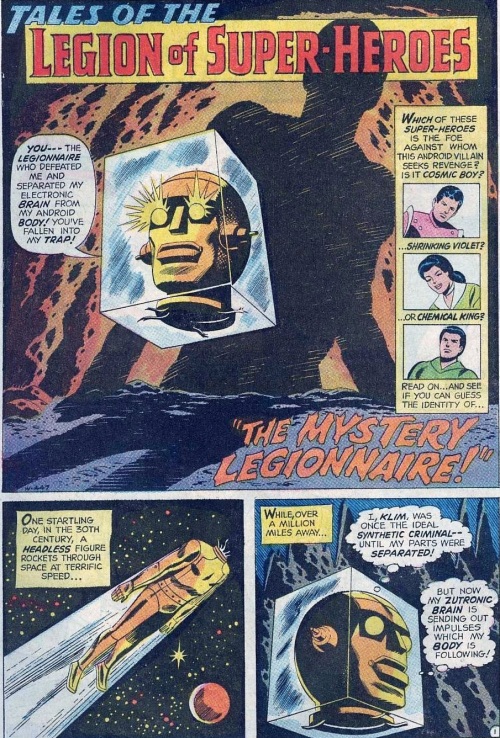






 Cover Artist: Nick Cardy
Cover Artist: Nick Cardy



















 Cover Artist: Neal Adams
Cover Artist: Neal Adams











 Cover Artist: Curt Swan
Cover Artist: Curt Swan















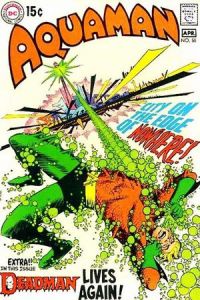 Cover Artist: Nick Cardy
Cover Artist: Nick Cardy










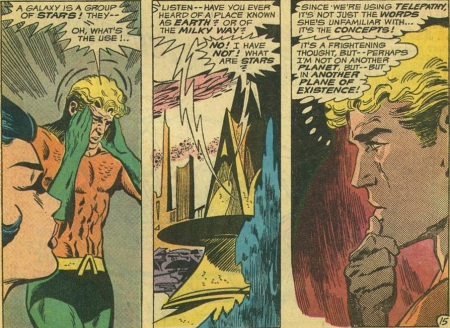
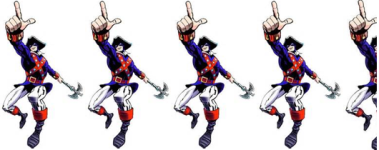


 Kushna informs Brand that he can begin his quest, but first he must address a danger that threatens the entire world, and she points him towards the aquatic villain without much more explanation. Deadman pops in on Orm and plays fly on the wall long enough to observe him plant some sort of device and meet with a bizarre pair of aliens near a otherworldly craft. I’m not crazy about the design of these aliens, as they are a bit too Silve Age-y for my tastes, but I’ll be darned if they don’t look quite striking in Adam’s stark pencils.
Kushna informs Brand that he can begin his quest, but first he must address a danger that threatens the entire world, and she points him towards the aquatic villain without much more explanation. Deadman pops in on Orm and plays fly on the wall long enough to observe him plant some sort of device and meet with a bizarre pair of aliens near a otherworldly craft. I’m not crazy about the design of these aliens, as they are a bit too Silve Age-y for my tastes, but I’ll be darned if they don’t look quite striking in Adam’s stark pencils.

 Executive Editor: Carmine Infantino
Executive Editor: Carmine Infantino








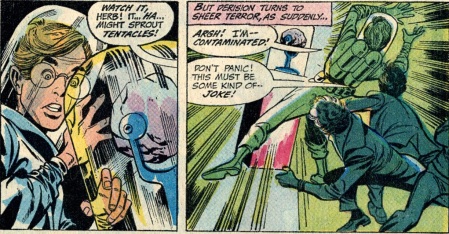












 That brings us to the backup feature of this comic, as well as the real star tale of this book, The Legion of Super-Heroes. This story is really a nice inversion of the previous month’s offering. In that by the numbers yarn, Dream Girl had a vision of a Legionnaire’s death, and the heroes struggled to prevent it. This month’s back-up also involves the heroes trying to fight against fate, but this time it is the villains who have the visions! Star Boy heads to his home planet with Saturn Girl and Colossal Boy to investigate a series of robberies by a gang that always seems to be one step ahead of the authorities.
That brings us to the backup feature of this comic, as well as the real star tale of this book, The Legion of Super-Heroes. This story is really a nice inversion of the previous month’s offering. In that by the numbers yarn, Dream Girl had a vision of a Legionnaire’s death, and the heroes struggled to prevent it. This month’s back-up also involves the heroes trying to fight against fate, but this time it is the villains who have the visions! Star Boy heads to his home planet with Saturn Girl and Colossal Boy to investigate a series of robberies by a gang that always seems to be one step ahead of the authorities.









 Aquaman’s telepathic commands, and they are soon fighting for their lives. A strange figure in a diving suit shows up to help them, and it turns out to be Phil Darson, a somewhat enigmatic scientist and explorer who the Aquatic Ace had encountered some issues back. It seems that the mysterious malady plaguing the fish is the reason Aquaman has been summoned to these cold climes. The heroes meet up with Arthur’s “old friend,” Professor Davidson, and Aparo gives this briefly appearing, one-shot character a really distinct face. One look at this guy and you get a sense of his personality. He’s serious, grizzled, and worried, and we know this before he ever opens his mouth. That’s the power of a good artist right there.
Aquaman’s telepathic commands, and they are soon fighting for their lives. A strange figure in a diving suit shows up to help them, and it turns out to be Phil Darson, a somewhat enigmatic scientist and explorer who the Aquatic Ace had encountered some issues back. It seems that the mysterious malady plaguing the fish is the reason Aquaman has been summoned to these cold climes. The heroes meet up with Arthur’s “old friend,” Professor Davidson, and Aparo gives this briefly appearing, one-shot character a really distinct face. One look at this guy and you get a sense of his personality. He’s serious, grizzled, and worried, and we know this before he ever opens his mouth. That’s the power of a good artist right there.



 He follows the criminal, but it seems he breaks in on the factory owners planned ambush, and nobody is happy to see him! In another close call, Aquaman takes shrapnel from a grenade that explodes practically on top of him. That is two explosions he has survived, making him one tough son of a gun, right? Well, then we see one of the weaknesses of this series, as he is taken out by a clot to the head, in true DC hero fashion. I swear, if I had a penny for every time a DC hero is disabled by a blow the back of the head, I’d be living in my own underwater city….
He follows the criminal, but it seems he breaks in on the factory owners planned ambush, and nobody is happy to see him! In another close call, Aquaman takes shrapnel from a grenade that explodes practically on top of him. That is two explosions he has survived, making him one tough son of a gun, right? Well, then we see one of the weaknesses of this series, as he is taken out by a clot to the head, in true DC hero fashion. I swear, if I had a penny for every time a DC hero is disabled by a blow the back of the head, I’d be living in my own underwater city….




 The Senator convinces Bruce to fly back to D.C. with him to help with a crime bill that’s supposed to really make waves, and on the way, the flight is hi-jacked by his political enemies! In a nice little touch, the pilot seems, not scared as you’d imagine, but nonplussed and wearily resigned, if anything. “Not another Havana Hijacker,” he says grumpily. Apparently this period, from ’68-’79 is the
The Senator convinces Bruce to fly back to D.C. with him to help with a crime bill that’s supposed to really make waves, and on the way, the flight is hi-jacked by his political enemies! In a nice little touch, the pilot seems, not scared as you’d imagine, but nonplussed and wearily resigned, if anything. “Not another Havana Hijacker,” he says grumpily. Apparently this period, from ’68-’79 is the 










 The whole plot turns on the idea that there is this young whiz kid named Rory Bell who is a stock genius, and makes all of his business decisions while riding a motorcycle and talking to his secretary/girlfriend via “radio-phone”! To add to the oddness of this concept, apparently a gang of crooks who are feeling a bit out of date decide that the best way to turn things around is to kidnap this kid and have him make a fortune on the market for them. We are on page 2.
The whole plot turns on the idea that there is this young whiz kid named Rory Bell who is a stock genius, and makes all of his business decisions while riding a motorcycle and talking to his secretary/girlfriend via “radio-phone”! To add to the oddness of this concept, apparently a gang of crooks who are feeling a bit out of date decide that the best way to turn things around is to kidnap this kid and have him make a fortune on the market for them. We are on page 2.








 Back to our mystery. Barbara gets a nibble, and her date is a mousy little fellow who seems harmless…until he offers her an orchid and moves in for a kiss. Babs rebuffs his advances rather…decisively, and he storms off. She follows, not quite sure if this is just natural frustration or something more sinister, and she loses him, only to be grabbed, apparently by the orchid killer himself!
Back to our mystery. Barbara gets a nibble, and her date is a mousy little fellow who seems harmless…until he offers her an orchid and moves in for a kiss. Babs rebuffs his advances rather…decisively, and he storms off. She follows, not quite sure if this is just natural frustration or something more sinister, and she loses him, only to be grabbed, apparently by the orchid killer himself!
 This backup ticks right along, but it manages to tell a complete story, so far as it goes, in only 9 pages. I’m not quite sure what I think of the opening dream sequence. It does establish a good, creepy tone and a sense of threat about this killer, but I wonder if that page could have been put to more effective use. Nonetheless, packing all of that story into 9 pages is pretty impressive, and Robins does it very efficiently. You get some characterization, some supporting cast, some civilian identity, some superheroing, and some detective work. Not bad. I’ll give it 3.5 Minutemen.
This backup ticks right along, but it manages to tell a complete story, so far as it goes, in only 9 pages. I’m not quite sure what I think of the opening dream sequence. It does establish a good, creepy tone and a sense of threat about this killer, but I wonder if that page could have been put to more effective use. Nonetheless, packing all of that story into 9 pages is pretty impressive, and Robins does it very efficiently. You get some characterization, some supporting cast, some civilian identity, some superheroing, and some detective work. Not bad. I’ll give it 3.5 Minutemen.


 Anyway, this young lady gets a bad fright during the fight and passes out, so the Flash naturally takes her to a hospital where professionals can take care of her and…wait…what? No, no, no, don’t be silly. Instead, at Iris’s insistence, he brings her to his home where he can more conveniently endanger his secret identity. The girl awakes and calls the Scarlet Speedster “Daniel,” giving him a SUPER creepy look in the process.
Anyway, this young lady gets a bad fright during the fight and passes out, so the Flash naturally takes her to a hospital where professionals can take care of her and…wait…what? No, no, no, don’t be silly. Instead, at Iris’s insistence, he brings her to his home where he can more conveniently endanger his secret identity. The girl awakes and calls the Scarlet Speedster “Daniel,” giving him a SUPER creepy look in the process.










 We join that security guard, who seems to be more than meets the eye. No, he’s not a transformer, but the way he ducks the hoodlums who come gunning for him implies that he’s got some skills. Apparently he’s being hunted, and he feels his only hope is the Justice League! He reads about the League making a charity appearance, and he figures that is his chance. This page also gives us a pick-up line delivered by Green Arrow with a creepy and altogether too intense look on his face. Way to play it cool, Ollie. At the event, just as the new Leaguer, Black Canary, is being introduced, this unusual guard forces his way through the crowd, assassins hot on his heels. The League leaps into action in a rather nice display of their collective skills and teamwork, and the guard reveals his identity and his story.
We join that security guard, who seems to be more than meets the eye. No, he’s not a transformer, but the way he ducks the hoodlums who come gunning for him implies that he’s got some skills. Apparently he’s being hunted, and he feels his only hope is the Justice League! He reads about the League making a charity appearance, and he figures that is his chance. This page also gives us a pick-up line delivered by Green Arrow with a creepy and altogether too intense look on his face. Way to play it cool, Ollie. At the event, just as the new Leaguer, Black Canary, is being introduced, this unusual guard forces his way through the crowd, assassins hot on his heels. The League leaps into action in a rather nice display of their collective skills and teamwork, and the guard reveals his identity and his story.

 The more street-level characters head out to investigate the factory, while Superman and GL head out to investigate the location on a star map discovered in the papers. Green Arrow, being Green Arrow, tells everybody else that he’s got his own plans. He marches into city hall and gives the assistant city manager an earfull. In an agressive verbal boxing match, the two yell at each other, with Ollie saying things that may have been a bit shocking in 1970 but seem utterly mundane now, basically that we should probably not poison ourselves or our environment for a buck. He deploys his usual diplomatic subtlety, insulting the official and screaming in his face. The manager is having none of it and has the masked hero arrested!
The more street-level characters head out to investigate the factory, while Superman and GL head out to investigate the location on a star map discovered in the papers. Green Arrow, being Green Arrow, tells everybody else that he’s got his own plans. He marches into city hall and gives the assistant city manager an earfull. In an agressive verbal boxing match, the two yell at each other, with Ollie saying things that may have been a bit shocking in 1970 but seem utterly mundane now, basically that we should probably not poison ourselves or our environment for a buck. He deploys his usual diplomatic subtlety, insulting the official and screaming in his face. The manager is having none of it and has the masked hero arrested!


